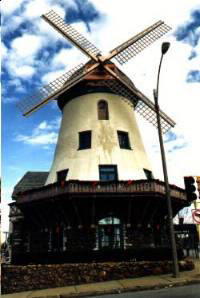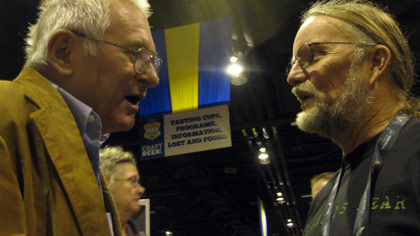Catching up after 10 days offline (and often off the grid), I see that Eric Asimov of the New York Times devoted his column Wednesday to Overcoming a Frat Party Reputation, an even-handed look at modern day beer culture.
He framed the story by venturing to Boston to share beers with Todd and Jason Alström of Beer Advocate. Asimov writes correctly:
Each of the Web sites has its partisans, and crossover is common, but at beeradvocate.com, discussions seem to get louder, arguments rage more fiercely and passions flow close to the surface.
Asimov repeatedly gets to the point: “. . . the real action in beer culture takes place on a far more visceral level, in the rants about why so many good restaurants have wine lists as thick as books but only carry three beers, or whether beer lovers have a bias against big breweries, or whether high-alcohol extreme beers are great or ruinous.”
And I really like what he notices at the end (go read it). But – and you knew this was coming – there’s something that bugged me.
“One of our main goals is trying to raise the image of beer as a whole and bring back the beer culture,” Todd said. “We had a beer culture but Prohibition kind of reset the button.”
Not exactly. Maureen Ogle surely grimaced if she read this, because in Ambitious Brew she endeavored to correct the oft-told (but factually inaccurate) tale that America had a booming beer culture before Prohibition and that big, greedy brewers flattened it after the Noble Experiment failed.
Bob Skilnik further substantiates that this is a myth in Beer and Food: An American History (more on that book later in the week).
(more on that book later in the week).
Beer itself began to change in the 1870s – lager took over, beer factories took over, beer brewed with adjuncts took over. And the places where people drank beer also changed. Both Ogle and Madelon Power (Faces along the Bar) document the role the Anti-Saloon League in the ultimate success of those in the Prohibition movement. The Anti-Saloon League would not have succeeded if saloons had not provided plenty to be against.
 It’s not like brewers didn’t know what was going on. In 1916, August A. Busch – the second member of his family to guide Anheuser-Busch – built the Bevo Mill in St. Louis as part of an effort to associate beer with something other than wicked saloons.
It’s not like brewers didn’t know what was going on. In 1916, August A. Busch – the second member of his family to guide Anheuser-Busch – built the Bevo Mill in St. Louis as part of an effort to associate beer with something other than wicked saloons.
Kind of a Here’s to Beer of the early twentieth century. By then, Busch had already launched Bevo, which took its name from the Bohemian pivo (beer) and contained less than one-half percent alcohol. The Bevo Mill, a replica of a Dutch windmill, was a high-class restaurant, with beer and wine (no hard liquor) available only at tables. There was no bar. No sawdust. No bawdy women.
Yes, you could say he was battling windmills with a windmill. That didn’t hold off Prohibition, as you know, but the restaurant still operates today.
My point would be that we are not returning to the past glory days of American beer and beer emporiums. These are the glory days. Peruse the Brewers Association Beer Style Guidelines, all 41 pages, and ask yourself how many of those styles were available in 1870 or 1915. And that’s before we get to the matter of quality.
It’s only been 30 years since Jack McAuliffe launched the short-lived New Albion Brewing Co. so we’re at what? Chapter Two? Chapter Three? This is creation, not re-creation, which is why matters like ingredients, batch size, shaking the frat boys image, and so on are important.

 It’s not like brewers didn’t know what was going on. In 1916, August A. Busch – the second member of his family to guide Anheuser-Busch – built the Bevo Mill in St. Louis as part of an effort to associate beer with something other than wicked saloons.
It’s not like brewers didn’t know what was going on. In 1916, August A. Busch – the second member of his family to guide Anheuser-Busch – built the Bevo Mill in St. Louis as part of an effort to associate beer with something other than wicked saloons.